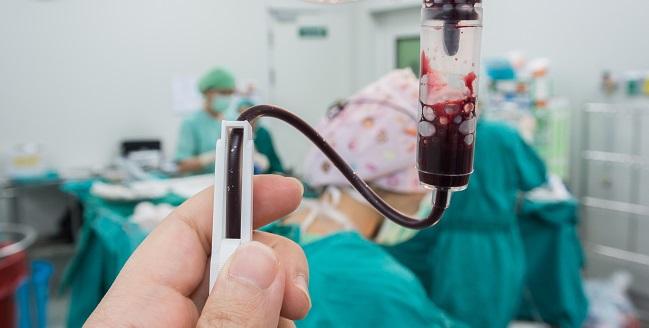Baseline Anemia Ups Physician-Guided DAPT Discontinuation Rates After PCI
The findings should spur physicians to have bleeding avoidance strategies in place before PCI among all—but especially anemic—patients, authors say.

Patients with baseline anemia undergoing PCI are more likely to discontinue dual antiplatelet therapy (DAPT) under physician guidance within 1 year—a strategy deemed safe—than their nonanemic counterparts, according to new data from the PARIS registry. Importantly, the mode of DAPT cessation among all patients can affect their risk of adverse events over 2 years.
“It is important to kind of think about the anemic patients not just in terms of bleeding, but also in terms of ischemic events when you disrupt or discontinue therapy,” senior study author Roxana Mehran, MD (Mount Sinai Hospital, New York, NY), told TCTMD. “If it's a recommended discontinuation, there were no major issues.”
Because of this, physicians should proactively have bleeding avoidance strategies in place for anemic patients, who are more prone to both ischemic or bleeding events, she added. “If you guide the discontinuation earlier, you're better off, rather than them going on for a whole year and having an event of bleeding.”
DAPT Disruption Affects All
For the study, published online this week in Circulation: Cardiovascular Interventions, Mehran along with Michela Faggioni, MD (Icahn School of Medicine at Mount Sinai, New York, NY), and colleagues looked at more than 4,000 PCI patients from the PARIS registry with baseline hemoglobin data available, of whom 18% were anemic (defined as baseline hemoglobin < 12 g/dL for men and < 11 g/dL for women).
Within 2 years of PCI, anemic patients were more likely than nonanemic patients to disrupt their DAPT (defined as a stoppage due to bleeding or noncompliance) or interrupt their DAPT (defined as a voluntary and temporary pause of no more than 14 days for surgery or another invasive procedure as guided by a physician).
DAPT Interruption and Disruption Over 2 Years
|
|
Anemic Patients |
Nonanemic Patients |
Log-rank P Value |
|
Interruption |
|
|
|
|
30 Days |
1.0% |
0.2% |
|
|
365 Days |
6.6% |
4.0% |
0.009 |
|
730 Days |
12.8% |
9.6% |
|
|
Disruption |
|
|
|
|
30 Days |
2.6% |
2.1% |
|
|
365 Days |
12.2% |
9.0% |
0.033 |
|
730 Days |
16.4% |
13.7% |
|
DAPT discontinuation was defined as physician-guided withdrawal occurring when therapy was no longer needed, and was more common among anemic patients in the first year (13.1% vs 10.8%) and in nonanemic patients in the second year following PCI (33.6% vs 41.0%).
Anemia adds a wrench into the decision-making process, and we need much more data to evaluate what works better. Roxana Mehran
Patients presenting with baseline anemia reported more than doubled rates of BARC 3 or 5 bleeding as well as a significantly higher prevalence of ischemic adverse events like cardiac death, spontaneous MI, and MACE at 1 and 2 years after PCI compared with nonanemic patients (P < 0.01 for all). Both the risks of MACE and bleeding progressively increased with the severity of baseline anemia.
Interestingly, neither DAPT discontinuation nor interruption among anemic patients increased the risk of any clinical adverse event over 2 years. On the other hand, DAPT disruption significantly increased the risks of both MACE and MI for both anemic and nonanemic patients.
Because anemic patients are generally excluded from DAPT clinical trials, Mehran said this study “opens the door” to further research of this population. “We're treating these patients less and less with dual antiplatelet therapies, and it is also important to think about their ischemic burden,” she said. “Anemia adds a wrench into the decision-making process, and we need much more data to evaluate what works better.”
Note: Mehran is a faculty member of the Cardiovascular Research Foundation, the publisher of TCTMD.
Yael L. Maxwell is Senior Medical Journalist for TCTMD and Section Editor of TCTMD's Fellows Forum. She served as the inaugural…
Read Full BioSources
Faggioni M, Baber U, Sartori S, et al. Influence of baseline anemia on dual antiplatelet therapy cessation and risk of adverse events after percutaneous coronary intervention: insights from the PARIS registry. Circ Cardiovasc Interv. 2019;12:e007133.
Disclosures
- The PARIS registry was sponsored and funded by Bristol-Myers Squibb and Sanofi-Aventis.
- Mehran reports receiving institutional grant support from The Medicines Company, Bristol-Myers Squibb/Sanofi, Eli Lilly and Company/Daiichi Sankyo, OrbusNeich, Bayer, and CSL Behring; serving as a consultant to Janssen Pharmaceuticals, Osprey Medical, Watermark Research Partners, and Medscape; and serving as part of the advisory board of Abbott Laboratories.


Comments